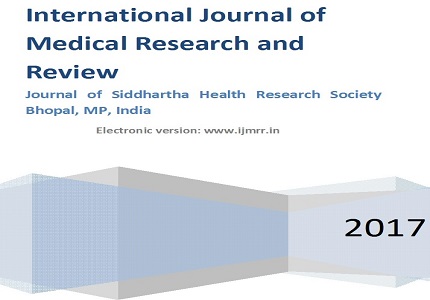Post-Neonatal tetanus from broomstick injuries: a word of caution for caregivers
Abstract
Tetanus is a vaccine-preventable disease that is acquired through exposure to the spores of the bacterium Clostridium tetani which are ubiquitous in the soil. Post-neonatal tetanus is an increasing problem in developing countries, including Nigeria. This is mainly as a result of inadequate immunization coverage, unsustainable immunization programmes, and non-administration of booster doses of tetanus toxoid at appropriate periods to eligible children. The spores of the bacterium can get into the body through broken skin, commonly through injuries from contaminated objects. There have also been reports of broomstick injury as the portal of entry. Indeed, it has been reported to be the commonest portal of entry in a center in Nigeria. This is important because flogging (of children) with brooms is common in parts of Nigeria, despite it being forbidden in several cultures in the country. Two cases of post-neonatal tetanus arising from broomstick injuries in Uyo, Nigeria, are herein reported, to illustrate the inherent dangers and implications of broomstick injuries in children. It is hoped that advocacy campaigns will be conducted at different public health fora to raise awareness of the general population concerning post-neonatal tetanus from broomstick injuries. Furthermore, there is urgent need to institutionalize the administration of booster doses of tetanus toxoid at primary and secondary school entry.
Downloads
References
World Health Organization (WHO). Tetanus. Available from: http://www.who.int/immunization/monitoring_surveillance/burden/vpd/surveillance_type/passive/tetanus/en/.2017; Accessed: 08.07.2017.
Animashaun BA, Gbelee OH, Ogunlana AT, Njokanma OF, Odusanya O. Profile and outcome of patients with post-neonatal tetanus in a tertiary centre in south west Nigeria: any remarkable reduction in the scourge? Pan African Medical Journal. 2015; 21:254. DOI: https://dx.doi.org/10.11604%2Fpamj.2015.21.254.6488.
Oyedeji OA, Fadero F, Joel-Medewase V, Elemile P, Oyedeji GA. Trends in neonatal and post-neonatal tetanus admissions at a Nigerian teaching hospital. J Infect Dev Ctries. 2012; 6(12):847-853. Available: https://jidc.org/index.php/journal/article/download/23276738/802/.
Ide LEY, Uchenwa-Onyenegecha TA. Post Neonatal Tetanus: 20 Years Experience as Seen at the University of Port Harcourt Teaching Hospital. British Journal of Medicine & Medical Research. 2016; 12(2): 1-5. DOI: https://doi.org/10.9734/BJMMR/2016/19047.
Centers for Disease Control and Prevention (CDC). Tetanus: Causes and Transmission. 2017; Available from: https://www.cdc.gov/tetanus/about/causes-transmission.html. Accessed: 08.07.2017.
Ejike O, Chapp J, Onyire B, Amadi AN. Pattern And Outcome Of Childhood Tetanus In Aba. Journal of Medical Investigation and Practice.2003;(4):19-22. Available from: https://www.ajol.info/index.php/jomip/article/view/29010.
Talabi OA, Aigoro NO, Oyedeko MO, Akinbode RS, Salaudeen LK. Recurrent Local Tetanus: A Case Report. Nigerian Medical Practitioner. 2004;46(1):2 - 3.
Eberechukwu YIL, Angela B-ON. The Socio-Economic Challenges in Post Neonatal Tetanus. Modern Economy. 2015;(6):1327-1332. Available from: http://dx.doi.org/10.4236/me.2015.612125.
Alhaji MA, Akuhwa RT, Mustapha MG, Ashir GM, Mava Y, Elechi HA, Bukar FL. Post-neonatal tetanus in University of Maiduguri Teaching Hospital, North-eastern Nigeria. Niger J Paed. 2013; 40 (2): 154-157. DOI: http://dx.doi.org/10.4314/njp.v40i2,9.
Fatunde OJ, Familusi JB. Post Neo-Natal Tetanus in Nigeria: A Need for Booster Doses of Tetanus Toxoid. Nigeria Journal of Paediatrics.2001;28(2):38-38. Available: https://www.ajol.info/index.php/njp/article/view/ 12053. DOI: http://dx.doi.org/10.4314/njp.v28i2.12053.
Anah MU, Etuk IS, Ikpeme OE, Ntia HU, Ineji EO, Archibong RB. Post Neonatal Tetanus in Calabar, Nigeria: A 10 Year Review. Nigerian Medical Practitioner. 2008;54(2):45-47. Online, available: https://www.ajol.info/index.php/nmp/article/view/28947. DOI: http://dx.doi.org/10.4314/nmp.v54i2.28947.
Emodi IJ, Ikefuna AN, Obichukwu C. Incidence and outcome of neonatal tetanus in Enugu over a 10-year period. South African Journal of Child Health. 2011;5(4):117. DOI: 10.7196/SAJCH.373.
Chukwuka JO, Ezeudu CE, Nnamani KO. Neonatal and Post-Neonatal Tetanus in Nnamdi Azikiwe University Teaching Hospital, Nnewi, South-East, Nigeria: A 10-year review. Trop J Med Res. 2015 Jan - Jun;18 (1):30-33. DOI: http://www.tjmrjournal.org/text.asp?2015/18/1/30/152552.
Centers for Disease Control and Prevention (CDC). Tetanus: Symptoms and Diagnosis. 2017; Online, available: https://www.cdc.gov/tetanus/clinicians.html.
Mahmoud AO, Ayanniyi AA, Salman MF. Observations of teachers in llorin, Nigeria on their practices of corporal punishment that are potentially injurious to their pupils' eyes. Annals of African Medicine. 2011 April-June;10(2):150-154. Available from: http://www.bioline.org.br/request?am11030. DOI: https://doi.org/10.4103/1596-3519.82075.



 OAI - Open Archives Initiative
OAI - Open Archives Initiative


